The First Bengali Translation of the Holy Quran by Bhai Girish Chandra Sen (Part One)
Introduction
For the last few decades, many scholars, as well as many international figures, have embraced Islam, such as legendary Indian music composer AR Rahman, boxing champion Muhammad Ali, heavyweight champion Mike Tyson, the National Basketball Association player Kareem Abdul Jabbar etc. In most cases, the Quran is the source or reason for their acceptance of Islam as their way of life. For those who are not mastered Arabic, translations are the gateways to the meaning of the Quran.
One of the earliest versions of the Quranic translations attributed to Latin scholars in the western world was of Peter the Venerable.[i] The extent of these Quranic translations moved to the eastern world during the 10th to 12th centuries when the Samanid emperor, Mansur I, ordered a group of scholars from Khorasan to translate the Tafsir al-Tabari,[ii] originally in Arabic, into Persian, followed by translations of Khwaja Abdullah Ansari[iii] and Najm al-Din 'Umar al-Nasafi[iv] in the 11th and 12th centuries respectively.[v] However, it was not until the 18th century when translations of the Holy Quran in various vernacular languages emerged in the Indian subcontinent. Still, the details of these translations are not conversant to us. The only thing that we are aware of in this respect is the contribution of Shah Waliullah al-Dahlawi[vi] and his sons during the eighteenth century. The first known translation of the Quran was done by Shah Abdul Qadir under the tittle Muzih-e-Quran completed between 1790-91 and published later in 1829 during the British rule in India.[vii]
In India, there are 22 official languages as per the constitutional approval, out of which 17 languages have Quranic translations. Furthermore, there are many unrecognized languages, such as Bodo, Dogri, Konkani, Maithili, Santhali, etc. which also have translations of the Holy Quran. As for the Bengali language, to be more specific, there are around 35 or more translations of the Quran, and each one carries distinct features and characteristics that make it different from the others.[viii] One of these translations is Quran Shareef, the first ever known Bengali translation of the Quran, prepared by Bhai Girish Chandra Sen[ix] in 1886.
First Bengali Translation of the Quran
During the initial stage of the Quranic translation, Bengali scholars found it unhandy to give their description of the words of Allah for their version of comprehension and understanding. The major reason was that their testament might distort the meanings and teachings of the Quran. At the end of the day, it would be like any other religion where editions would be brought in as per the demand of their scholars. But this point of view did not linger there for a long while.
During British rule in India, Muslims were the major targets of the Britishers for ruling the nation for more than 600 years. The case with Bengali Muslims was quite extreme as they were the ones who first saw the Britishers with East India Company[x] in their hand and realized their intention of dragging their sovereignty from their hands. For these reasons, Muslims were kept away from their rituals and teachings. The best portrait of this devastating situation of Bengali Muslims can be found in the dialogue of Baptist Missionary William Carey[xi] who once asked the Muslims about the essence of the Quran and its teachings to their life and came to know how ignorant they were about their religious scriptures and knew nothing related to it.[xii]
The first attempt at Quranic translation was put forth by Aminuddin Basunia in 1808, which was not complete in nature and confined to the 30th part of the Quran. Later Muhammad Noymuddin translated only ten juzʼ[xiii] of the Quran. Therefore, the first complete as well as available version of the Quranic translation was done by Girish Chandra Sen in 1886. It was followed by Abbas Ali Candipuri who was the first Muslim translated the Quran in the Bengali language. Unlike the other translations done before Bhai Girish, Quran Shareef has been kept intact and people are availing from it whereas others are hardly found and that too to a very confined region or country.
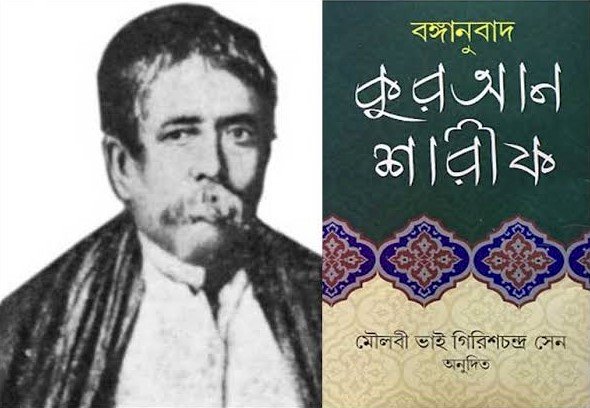
Quran Shareef
Unlike any other translation, Quran Shareef, first published in 1886, had a distinct feature among other translations of the Quran. Something that would strike the mind in the first place is its nature of being written by a non-Muslim and having the credit of being the first ever Bengali translation introduced by any Bengali.
Clarifying the extensive meanings of the Quran, the Quran starts with a disclaimer which is a verse of the Quran saying: {If all the trees on earth were pens and the ocean were ink, refilled by seven other oceans, the Words of Allah would not be exhausted. Surely Allah is Almighty, All-Wise}.[xiv] The verse itself denotes how careful the author had been throughout the exercise of translation in deriving out the meanings and giving them descriptions of the words of Allah the Almighty.
In the initial stage, the translation was completed in 12 volumes. The first volume was published in 1886 with the emission of the author's name and details, fearing the reactions of the Muslims finding out the contribution of a Brahmo Samaj non-Muslim to their holy scripture. But the apprehension of the author proved to be wrong when two Muslim communities sent praising notes to the Brahmo Samaj, felicitating what Bhai Girish has done as a part of their contribution to their religion and people. After completing the translation of the Quran, Bhai Girish Chandra Sen said: "Seeing the completion of the Quran today, I feel both joy and sadness in my mind. The matter of joy is that the hard work of so long was worth it. The sadness is that the first part of it was dedicated to the work of Shri Madacharya Keshavchandra, who was enthralled by it and awaited its end. But before he could see its last part, God took him away from us. He was such a fan of translation that he could not tolerate anyone criticising him. How happy he would have been to see the translation completed today, and also how blessed he would have been."
References
[1] Sen, Girish Chandra. Quran Shareef. 4 ed., vol. 1, Kolkata, Haraf Publications, 2015. 1 vols.
[2] Fatani, Afnan (2006). "Translation and the Qurʻan". In Leaman, Oliver (ed.). The Qurʻan: an encyclopedia. Great Britain: Routledge. pp. 657–669.
[3] Ali, Sher. “South Asian Quran Commentaries and Translations: A Preliminary Intellectual History.” 1 ed., vol. 5, ReOrient, 2020, p. 239. Accessed 8 February 2023.
[4] Shaffi, Sajid. “Qur’an Translations in Indian Regional Languages: A Bibliography.” ALIGARH JOURNAL OF QURANIC STUDIES, 1 ed., vol. 1, Aligarh Muslim University, 2018, pp. 143-155. Accessed 8 February 2023.
[5] Rahman, Mizanur. “The History of the Translation of the Holy Quran in Bengali: The Translation Example of Gulam Azad.” International Journal of Social, Political and Economic Research, 1 ed., vol. 1, IJOSPER, 2021, pp. 152-172. 8 vols. Accessed 8 Feb 2023.
[6] Islamic Foundation Bangladesh, translator. Al-Qur'anul Kareem. 36 ed., vol. 1, Dhaka, Islamic Foundation Press, 2007. 1 vols. Accessed 8 February 2023.
[7] Chandpuri, Oliur Rahman. Pobitro Qur'an. 2 ed., vol. 1, New Delhi, Goodwork Books, 2018. 1 vols. Accessed 8 February 2023.
[8] Dey, Amit. “Bengali Translation of The Quran and The Impact of Print Culture on Muslim Society In the Nineteenth Century.” vol. 1, Uniwersytet Wroclawski, 2012, pp. 1299-1315. Accessed 8 February 2023.
[9] Mohanta, Sambaru Chandra (2012). "Sen, Girish Chandra". In Islam, Sirajul (ed.). Banglapedia: National Encyclopedia of Bangladesh (Second ed.). Accessed 8 February 2023
Endnotes
[i] The Benedictine abbey of Cluny's abbot was Peter the Venerable. Despite not being declared a saint during the Middle Ages, he is revered today.
[ii] Muhammad ibn Jarir al-Tabari (838–923), a Persian scholar, wrote the Sunni tafsir Jāmiʿ al-bayān ʿan taʾwīl āy al-Qurʾān 'an tawl y al-Qur'an, also known as Tafsīr al-Ṭabarī.
[iii] A Muslim Sufi saint named Abu Ismael Abdullah al-Harawi al-Ansari resided in Herat.
[iv] Najm ad-Dīn Abū Ḥafṣ 'Umar ibn Muḥammad an-Nasafī (1067-1142) was a Muslim jurist, theologian, mufassir, muhaddith and historian.
[v] Fatani, Afnan (2006). "Translation and the Qurʻan". In Leaman, Oliver (ed.). The Qurʻan: an encyclopedia. Great Britain: Routledge. pp. 657–669.
[vi] Shah Wal Allah Dahlawi, an Indian theologian and proponent of modern Islamic philosophy, was the first to seek to reevaluate Islamic theology in the context of contemporary developments.
[vii] Sher Ali, (2020). South Asian Quran Commentaries and Translations: A Preliminary Intellectual History. ReOrient. Vol. 5. pp. 239.
[viii] Sajid Shaffi, (2018). Qur’an Translations in Indian Regional Languages: A Bibliography. Aligarh Journal Of Qur'anic Studies. Vol.1. Pp.143.
[ix] A Bengali scholar and interpreter of religion, Girish Chandra Sen lived from approximately 1835 till August 15, 1910. The Qur'an was first published in Bengali by him in 1886. He was a Brahmo Samaj missionary, a monotheistic sect of Hinduism.
[x] The East India Company was a joint-stock business that was first created in England and later became part of the British Empire in 1600. It was liquidated in 1874. It was established to conduct business in the Indian Ocean region, originally with the East Indies and afterwards with East Asia.
[xi] William Carey was an English Christian missionary, Particular Baptist minister, translator, social reformer and cultural anthropologist who founded the Serampore College and the Serampore University, the first degree-awarding university in India.
[xii] Abbas Ali Khan, Banglar Mosalmander Itihas, p.94.
[xiii] A juz is one of the thirty segments, each of varied lengths, into which the Quran is divided. In Iran and the Indian subcontinent, it is also known as para. The Qur'an contains 30 juz.
[xiv] Holy Quran, 28/31.
About the author: Sirajuddin Shaikh is a PG research scholar at Darul Huda Islamic University, Kerala, India. muhammadsiraju818@gmail.com.
Disclaimer
The views expressed in this article are the author’s own and do not necessarily mirror Islamonweb’s editorial stance.

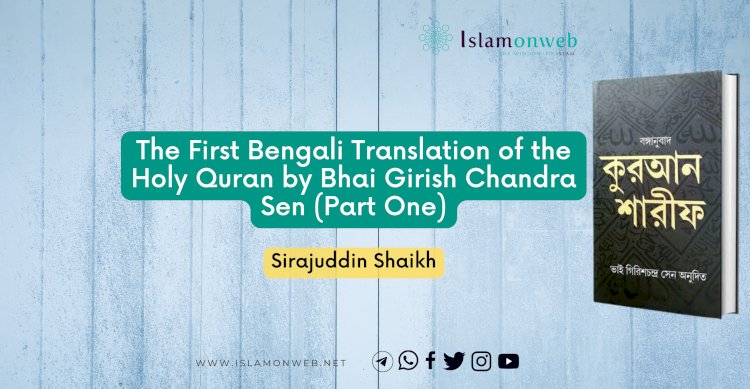


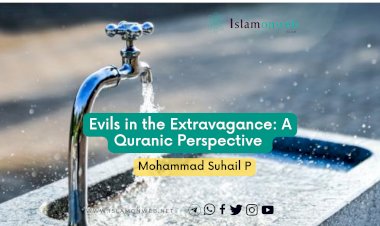

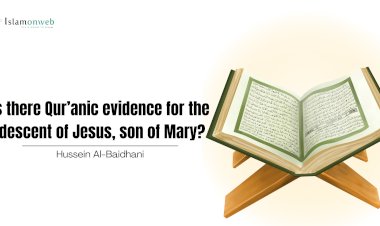
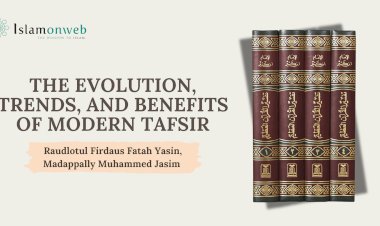

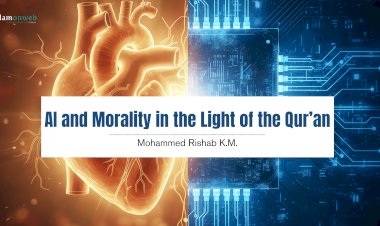














Leave A Comment